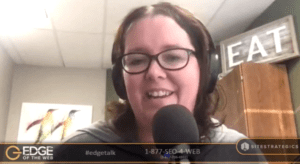 In EDGE of the Web Episode 302, EDGE hosts Erin Sparks (Site Strategics CEO) and Tom Brodbeck (Site Strategics Digital Media Director) speak with SEO expert Marie Haynes of Marie Haynes Consulting to find out about all the latest developments in the ever-changing world of SEO and Google algorithm updates (and yes, Google has done as many as 600 updates in one year). If you’d like to take a look at a timeline of Google updates, Marie has one that she updates here, and Moz has a decent one here (but Marie’s is better).
In EDGE of the Web Episode 302, EDGE hosts Erin Sparks (Site Strategics CEO) and Tom Brodbeck (Site Strategics Digital Media Director) speak with SEO expert Marie Haynes of Marie Haynes Consulting to find out about all the latest developments in the ever-changing world of SEO and Google algorithm updates (and yes, Google has done as many as 600 updates in one year). If you’d like to take a look at a timeline of Google updates, Marie has one that she updates here, and Moz has a decent one here (but Marie’s is better).
Marie Haynes: Her Background and Experience
When it comes to trying to understand Google’s algorithms, you won’t find someone more obsessed than Marie Haynes. She’s a frequent speaker at conferences like SMX and PubCon, and has her own growing agency called Marie Haynes Consulting. Marie’s pathway into the industry was not traditional, by any means. She used to be a veterinarian (one of her clients in those days was former Canadian Prime Minister Stephen Harper) when a back injury in 2008 had her spending a significant amount of time not working. Marie ended up building a veterinarian website and then wondered how she could get people to see it. From there she started teaching herself SEO techniques, becoming increasingly interested in how SEO works.
When the Google Penguin update came out in 2012 focused on dealing with “unnatural” links to websites, Marie realized most people didn’t understand it. As she posted her own thoughts and theories about what she thought was happening with it, people would ask her if she was available to do consulting work for them. This eventually led Marie to launch her own business around SEO consulting as she got great results for client. Now she leads a team of eight staff who diagnose and treat a whole different set of patients – people and companies with websites that aren’t ranking well on Google who need professional-grade site review and link audits.
Google Quality Rater Guidelines: The Big Picture
You can find a PDF online that’s something like 160+ pages. The guidelines were created for Google’s quality raters to show them how to evaluate a website. Quality Raters are not the same people on Google’s Web Spam Team, so they’re not out there taking manual actions and handing out penalties. The guidelines contain many criteria that the Quality Raters use to make judgements about websites. If a site has this, then it’s low quality. If it has that, then it’s high quality. The raters are tasked with evaluating test search results to see if the highest-quality sites are at the top of the SERPs. It’s a way for Google to assess whether or not their algorithm is accomplishing what they set out to do.
When these guidelines first came out, people didn’t see much practical value in them in terms of taking actions based on them to improve their website. But as the guidelines have been refined over the years (and became public in 2015), they’ve gotten much more specific and therefore more useful. But there’s not a one-to-one correlation between the guidelines and what’s in the Google algorithm. View them more like a set of guidelines that point towards what Google thinks is important to measure and which are therefore likely to make their way into the algorithm if they haven’t already been incorporated.
Google itself has said as much. The guidelines don’t explain exactly how the Google algorithm works, but they show where Google wants the algorithm to go. Anything that’s in the guidelines can be considered something that Google wants to measure algorithmically if they aren’t already doing so. In my site reviews, I use lots of different tools, including the Google Quality Rater Guidelines because it can be very useful to view a site through the lens of those guidelines. They are important. There is also speculation about whether this is part of some kind of machine learning effort, but Google has explicitly said that right now they are not using Quality Rater data for machine learning inputs. That’s not to say they won’t at some point, but not for now. The guidelines help test whether the algorithm is doing what the engineers want it to do.
Changes to the Guidelines in 2018
Updated guidelines usually come out in July of each year (but not always). Sometimes the updated version has only very minor changes in wording while other years see much more substantial changes. The 2018 update was significant. With this kind of update, the challenge is to take a very close look at the changes and try to figure out why they changed something and what it is that Google wants to assess or measure.
The biggest change in 2018 was the addition of the phrase “safety of users” in a couple of different places. This indicates to us that Google wants to figure out how to protect users from websites that are misleading. There’s a whole section in the guidelines about “deceptive practices” geared towards trying to protect users from what it thinks are untrustworthy websites.
A lot of sites took ranking hits from an unnamed September 27 update if there were things on their site that made it untrustworthy, or if there were other reputational factors that made the business untrustworthy. There’s a whole debate about whether Google is using information from the BBB (Better Business Bureau) in judging trustworthiness. Well, it’s in the Google Quality Rater Guidelines. If a business has a BBB rating of “F” then the quality raters should take that as one sign of low quality for the company’s website.
This is not, however, a black-and-white or one-to-one relationship, and it’s not like Google is using third-party data to determine its rankings. What they’re saying is that there’s a definite increasing emphasis on trust and authenticity, and if there is a pattern of indications across the web that people don’t like your business, and that is going to affect your page ranking. This relates to the Domain Authority tool from Moz and other similar tools that measure website strength using link quality as the primary criterion. Google is now starting to look at red flags outside of just links that could affect a site’s ranking.
The updates to the guidelines in 2018 are really centered around trust and authenticity. A bunch of sites took big ranking hits on January 31 of this year, and what those sites had in common is that people thought they were something else. For example, a lot of people go to irs.com thinking it’s the Internal Revenue Service website, but it’s not because the correct URL to get to the IRS is irs.gov, so irs.com would be considered misleading and the site took a big hit.
EAT: Expertise, Authoritativeness and Trust
New emphasis on EAT has been another big change in the guidelines. Why is EAT important? Look at it this way: If you received a serious medical diagnosis and wanted to learn more about it online, where do you want to get your information? From an article written by a content writer or an article written by an actual, bona-fide expert on the topic, like a doctor who has actually treated many cases of the condition over many years? It’s a way to separate out real experts from folks who are just good at research and SEO techniques. That’s a big change for SEO workers to deal with!
On February 7, 2017 there was a massive unnamed update to the Google algorithm, and a bunch of sites took major traffic hits that were even worse than when the Penguin update came out. The sites that took major hits were YMYL (your money or your life) sites that present content that could affect people’s health, happiness, safety, or financial stability. And the reason those sites took a hit was because they didn’t have credentialed experts contributing content. The similar sites that didn’t take hits were well-known, authoritative sites. The conclusion is that it was all about measuring EAT. And in the current version of the guidelines, EAT appears in there 186 times.
The remedy is that you have to look at how the sites that are doing well and see why. You can have the “E” of EAT and not rank because you lack the “A” and the “T.” For medical sites, the ones that are doing well on “A” (authority) provide references for every single medical or scientific statement made. You can’t have a site that is about a specific medical topic that doesn’t adequately reference the claims and statements made on the site with reputable sources, especially with the named Medic Update Google rolled out this past August 1. YMYL sites that contradicted documented science took a hit. It’s algorithmically pretty easy to evaluate references. And just because a person has done extensive writing on a topic doesn’t mean they satisfy the “E” criterion. If others don’t recognize you as an expert, then you won’t be considered an expert in the eyes of Google. To rank really well these days, you have to have real EAT. But this is also an emerging area for Google, and they don’t always get it right. There are sites that took a hit that should have been okay.
The disturbing thing about all this is that Google is trying to figure out what can and cannot be trusted, which is a thinly veiled way of judging what is true and not true. Yes, we all want to see less fake news and misinformation, but do we want to trust Google’s algorithm to be the primary or sole arbiter of that? Remember that Google is not yet using machine learning to do this, so they’re trying to figure it out algorithmically. The Google Owl update was an attempt to weed out fake news. And now YouTube says it’s changing the recommend algorithm to weed out conspiracy theories. But how are they doing that algorithmically? But, setting aside those big existential questions, the plain fact of the matter is that it’s happening and digital marketers have to figure out how to adapt to it.
If you want to improve your EAT, that’s going to be increasingly difficult unless you’re willing to put some real resources into having credentialed experts writing a significant chunk of the content. And fixing your Google ranking problems might come down to making real changes to your business practices to improve your reputation, such as how you handle customer complaints and things like that. Suddenly the SEO expert’s role is expanding outside the area of technical writing to include general business advice. Put your EAT material on your website’s home page above the fold to make a case for your trustworthiness. Even if it doesn’t help with your page ranking, it should help you get more conversions.
If you want to learn more from Marie Haynes about how Google algorithms, quality rater guidelines and EAT impact websites, listen to the full interview at EDGE of the Web Episode 302.
Connect with Dr. Marie Haynes
Twitter: @Marie_Haynes (https://twitter.com/Marie_Haynes)
Facebook: @MarieHaynesConsulting (https://www.facebook.com/MarieHaynesConsultingInc)
LinkedIn: https://www.linkedin.com/company/marie-haynes-consulting-inc/
Website: https://www.mariehaynes.com
Blog: https://www.mariehaynes.com/blog/
Search News You Can Use: https://community.mariehaynes.com/spaces/12735584/feed
Stop wondering about your digital marketing ROI and find out how you’re really doing. EDGE sponsor Site Strategics can put together a Digital Marketing ROI Report that examines your existing SEO, content, social media, and PPC. Visit https://edgeofthewebradio.com/roi/ to get 30% off a comprehensive review of your digital assets!


